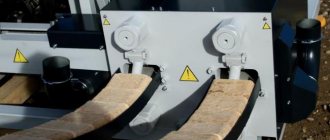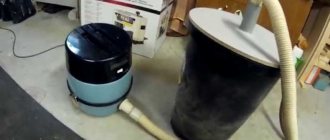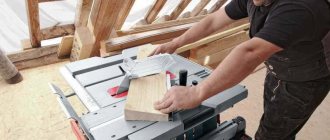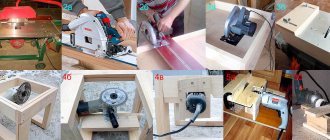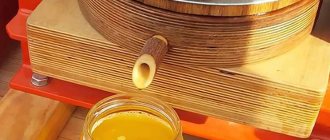Natural wood is highly valued in construction, furniture production and other areas of the national economy. Even the waste is used after processing. One of the directions is the pressing of sawdust, which results in the formation of briquettes that have a longer burning period than firewood and other types of solid fuel.
The design of presses differs slightly depending on the type; in general, it is a mechanical device that has a base, a power frame and a drive. The operating principle is to compact raw materials and form briquettes, fillers for pet trays.
The sawdust preparation process deserves special attention. They are pre-sorted, dried and crushed. This helps produce better products. In addition to sawdust, briquettes may include paper waste, nut shells and sunflower seed husks.
Before deciding to purchase a press, it is worth understanding the feasibility of its use. The equipment justifies the costs if there are available raw materials and a solid fuel boiler (or a market for the products).
Among the advantageous characteristics of the presses:
- rational use of wood waste (for heating premises, greenhouses, utility rooms, ash is used as fertilizer);
- clear and accessible production process;
- simple and reliable device (hydraulic models have virtually no high-wear components);
- Maintenance does not require knowledge of complex technologies.
Disadvantages include:
- the use of equipment involves the preparation of raw materials;
- rapid wear of components in the screw extruder;
- Some types require the addition of binders.
Types of presses
Presses used for processing sawdust come in 4 types. Differences between devices are noted in the principle of operation and cost.
The requirements for preparing raw materials are the same:
- uniform grinding to obtain fractions of no more than 25x25x2 mm;
- humidity level is within 4-10%.
Each model has both advantages and disadvantages, so before choosing, you should carefully read the technical characteristics:
- The mechanical impact press is similar in principle to a hammer drill, where the crank mechanism transmits a series of shocks to the piston with a frequency of 20 times per second. The impacts cause sawdust to be forced through the die. The equipment copes with pressing not only waste wood, but also a mixture of coal dust, straw, peat, and residues after processing MDF. The main advantage of the press is long-term operation without human intervention. High productivity is also noted. The weak point is the crank assemblies, which is due to the simultaneous impact of two forces on them: impact and friction.
- A hydraulic press is a device consisting of two parts (mold, cylinder). According to the principle of operation, the equipment resembles the action of a jack, where a hydraulic cylinder exerts pressure with a piston on a mold filled with prepared raw materials. The result is a formed briquette. The equipment is considered simple and reliable to use, there are practically no wear parts. The pricing policy for this type of model is competitive. The downside is low performance. There is also a nuance in the production process - a binding component is added to the prepared sawdust.
- The principle of operation of a screw press (extruder) is similar to a meat grinder. Crushed and dried sawdust is fed through a screw through a die, as a result of which the mass is compressed and pressed under high pressure. The process involves exposure to high temperatures, without which the equipment may jam. The hot flow provokes the release of lignin (a natural binder) from the wood, which holds small raw materials together and is the key to high-quality molding. The screw device is considered a leader in terms of productivity; the production process is carried out continuously. One of the disadvantages is the need for warming up, which makes the preparation procedure lengthy. You also need to take into account that the finished product has a lower calorie content due to exposure to high temperatures (above 120°C). Components such as the screw and die wear out quickly due to increased friction during operation.
- The pellet press is similar in principle to a feed pellet mill, only sawdust is used instead of grain crops. Compared to other types, the equipment has a simple structure, but at the same time it has good performance and an affordable pricing policy. The press is equipped with various devices to improve the quality of the resulting product. These are: a mixer for mixing raw materials, a humidifier for overdried workpieces, various cutting attachments that change the shape of the briquettes. The production process involves the use of an additional binder to increase density. One of the disadvantages is the need to grind the raw materials during preparation to the smallest fraction. Using such equipment it will be possible to produce briquettes only of small size.
Each model has both advantages and disadvantages, so before choosing, you should carefully read the technical characteristics
Types of forms of sawdust fuel briquettes
There are three forms obtained during the pressing process:
- Bricks are a form of RUF. Dimensions - 150x100x60 mm. Briquette humidity is up to 10%, density is about 1.2 g/cm3. The heat transfer is 4400 kcal/kg. These briquettes are low-ash and burn well. The package weighs 10 kilograms and contains 12 briquettes. They are produced by cold pressing and have a long shelf life of 3 years.
- Pencils – Pini Kay. Humidity, heat transfer and density indicators are similar to RUF. Dimensions -250x60 mm, with a hole with a diameter of 18-20 mm. They burn perfectly due to the presence of a hole in the middle of the briquette. Additional traction is created. Made by screw pressing at high temperatures. Shelf life up to five years.
- Cylinders - NESTRO. The moisture content of briquettes is from 8 to 10%. Density -1.0 g/cm3. Heat transfer 3900 kcal/kg. They have a length from 200 to 380 mm. The diameter of such a cylinder is 90 mm. Briquettes are made by pressing at medium pressure. They have a shelf life of only a year and the ash content is higher than the other two.
Briquettes made from RUF sawdust
burn best and are stored for a long time by Pini Kay and RUF. Good for heating a house and lighting a bath. Cylinders are best used for heating non-residential premises due to their higher ash content.
Equipment selection
When choosing a sawdust press, important factors to consider are:
- purpose of equipment;
- what raw materials does it work with;
- type of briquettes produced;
- device power;
- planned volume of finished products;
- complete with other equipment to obtain a high quality product;
- functionality of the selected model;
- operating mode of the unit and features of its maintenance.
You also need to pay attention to components that are subject to wear. Frequent repairs and their cost will help determine the rationality of purchasing a particular model.
When choosing a press for personal use, you should remember that the equipment should be simple with the ability to customize parameters. If the product is not planned to be put up for sale, then it is enough to purchase just one unit. To make your purchase cheaper, you can take advantage of interesting offers on the sale of used devices.
When choosing a press for personal use, you should remember that the equipment should be simple with the ability to customize parameters
Production scheme
The production of pellets occurs in several stages:
- First, the incoming raw material goes through the first stage of grinding, breaking it into fragments 25*25*2mm. This stage is necessary for more uniform and faster drying. Raw materials are fed into the crushers by a scraper; they should be stored on a concrete floor to prevent the ingress of soil, sand and stones.
- Then the semi-finished product is brought to a moisture content of 8-12% in belt or drum dryers. In all technology, this is the most energy-intensive process, but the quality of the fuel depends on the degree of moisture content of the raw materials. On average, it takes 1 MW of energy to bring 1 ton of raw materials to the required humidity. To reduce costs, bark or other substandard raw materials can be burned in dryers.
- The resulting mass is finely crushed (particles no more than 4 mm, for high-quality granules 1.5 mm) using hammer mills.
- If during the drying process the moisture content of the raw material drops below 10%, the semi-finished product is moistened with finely dispersed water or steam. Steam is necessary for hard wood (oak, etc.) or for stale raw materials. For soft wood or quality raw materials, water is sufficient. Screw mixers are usually used at this stage.
- The resulting product is pressed. The press can have a flat or cylindrical die. The size of the matrix determines the performance of the installation. The amount of raw material produced per unit of time also depends on the diameter of the granules.
- The pellets heated during pressing are cooled. During cooling, their moisture content decreases, which improves quality.
- The granules are sifted and packaged. Sometimes they are stored in bulk in bins, but in order to maintain the quality unchanged, it is advisable to package the products in large bags - big bags, which are delivered to the consumer. The highest quality products are packaged in bags of 20-25 kg.
Do it yourself
The high cost of equipment does not always justify the cost of purchasing it, so craftsmen implement their designs to create homemade presses. It is worth noting that making a screw device is quite difficult, so not everyone undertakes this type of pressing.
At home, it is almost impossible to achieve the required level of pressure that would ensure the release of lignin. But it is quite possible to build hydraulic units and granulators with your own hands.
All homemade devices are divided into three main types:
- The sawdust briquetting technology itself is quite interesting and has its advantages, so owners do not deny themselves the desire to acquire a home press
from jacks;
- with manual drive;
- with hydraulic drive.
The sawdust briquetting technology itself is quite interesting and has its advantages, so owners do not deny themselves the desire to acquire a home press.
Thanks to the use of briquettes, it is possible to prevent the formation of debris near the firebox of a stove or boiler, as well as to eliminate frequent loading. The location of home-made units can be wall-mounted or floor-mounted, depending on how convenient it is for you.
Before you begin assembling the press, you need to take into account all stages of the production process to ensure drying and grinding of raw materials. It is also worth taking care of a utility room or shed for storing finished products.
To assemble a hydraulic press, you will need to prepare the following materials and tools:
- metal sheet 4-6 mm;
- corner 100x100 mm;
- channel;
- a pipe with thick walls (the diameter is determined by the size of the briquettes at the outlet);
- pipe 25-30 mm for making a punch rod;
- galvanized steel for forming trays;
- large pipe or sheet of metal for making the mixer body;
- welding machine and electrodes;
- grinder with discs;
- drill;
- hammer;
- measuring devices, etc.
Methods for making briquettes
To get an idea of how you can make fuel briquettes with your own hands, you must first study how they are produced in a factory. The preparatory stage for any technology is the same and consists of grinding and drying the raw materials. These are, of course, sawdust and larger wood waste, which are processed to make briquettes. Then the raw material is dried in order to bring its moisture content to no more than 8-10%.
For reference. Also, various agro-industrial wastes (husks, seed husks) and even coal dust can serve as the starting material for the production of Euro-firewood.
Then the main operation begins - briquetting, in other words, sawdust pressing. Today this is done in two ways:
- Forming briquettes from sawdust on a hydraulic press.
- Production by extrusion method.
It must be said that with both technologies the result is achieved through strong compression of wood raw materials, as a result of which a natural component begins to be released from it - lignin. It serves as a binder for this crumbly mass; no other is provided. The only difference is in the compression method; in the first case, a hydraulic press for briquettes is used, developing a force of 300-600 Bar.
Due to such compression, the raw material spontaneously heats up, which only contributes to the formation of a strong rectangular “brick”. How a briquetting line with a hydraulic press functions is shown in the video:
This is how European firewood is squeezed out using a screw press
The extrusion method for producing briquettes from sawdust can be easily understood using the example of an ordinary home meat grinder or juicer. Raw materials are loaded into the receiving hopper of the unit and moved by a screw into a tapering conical working channel. There it is compressed, while the screw press for briquettes develops a monstrous force - up to 1000 Bar.
The output is firewood from sawdust in the form of a hexagon, which undergoes additional heat treatment and is cut to one size with a special knife. The sectional structure of a screw press for sawdust is shown in the drawing:
The main load falls on the auger (item 5) and the conical bushing (item 7), wear of the parts directly depends on the number of extruded briquettes
The design is made on the basis of a hydraulic installation
Step-by-step instructions for making a press
- To make the base, you need to connect the parts from the channel by welding.
- Cut 4 pieces 1.5 m long from the corners (they are used as stands). Weld them to the base at the same distance from each other (vertical location).
- Fix a drum made from a large diameter pipe to the corners. If such a pipe is not at hand, you can make the mixer body from a sheet of tin. To increase productivity, it is equipped with an electric motor.
- A box for filling raw materials is made from sheet iron. It is recommended to make the body shape in the form of a cone for spontaneous loading movement when filling the trays.
- The gearbox is fixed to the bottom of the cone-shaped body and a tray for the output product is welded.
- In a thick-walled pipe, make holes at intervals of 3-5 mm. When pressure is applied to the mass, air and water will escape through the holes. Weld a flange to the bottom of the workpiece that will hold the removable bottom. The bottom is made of a sheet of steel in the form of a circle with eyes.
- Weld the matrix to the base under the cone-shaped body.
- Cut a disk from a steel sheet of a size that would allow free movement in the matrix. It performs the function of a punch.
- Weld the prepared pipe for the rod to the punch. The other edge is attached to the hydraulic unit.
- The assembled unit is mounted on racks directly above the matrix.
- The receiving tray is installed in such a way that it does not interfere with the process of shooting and fixing the matrix bottom.
Pre-drying will be provided by heating elements installed around the perimeter of the machine. The briquettes will be ready for final preparation in an open area with low air humidity.
According to the technological process, raw materials need to be prepared before processing, which means a dryer and a grinding device are required
Presses for baling scrap metal: review of models, their characteristics
The need for pressing metal raw materials and scrap is determined primarily by the need to reduce storage and transportation costs; almost all recycling enterprises use it in compacted form. Despite the insignificant energy consumption and the high cost of the equipment itself, this work is paid off by the ability to control the density and size of the resulting packages, reduce the volume and ease of further use. For these purposes, machines and complexes with different capacities are used - from briquetting small chips to car recyclers; in order to avoid unnecessary expenses, it is important to select them in accordance with the tasks and the density of the processed recyclables.
Description of the device, scope and objectives of application
A standard scrap metal press is horizontal and consists of the following components:
- Drive (for most powerful models, the force is generated under the action of a hydraulic pump connected to an electric motor, less often to an autonomous internal combustion engine. Compact metal balers use pneumatics).
- Working cylinders.
- Loading and pressing chambers. The walls of the latter and the inner surface of the cover are armored; the main working rod is attached to the upper part.
The principle of its operation is simple: metal waste entering through the loading unit fills the press chamber, after a certain volume, pneumatic or hydraulic cylinders are activated, starting from horizontal and ending with vertical ones. To simplify processing processes, the chamber lid and the upper edges of the walls are often equipped with replaceable cutting plates that act as knives. At standard extraction units, the package is pushed out of the pressing zone by a punch.
This equipment is energy-intensive (the consumption of certain types of industrial hydraulic presses reaches 750 kW), depending on the force created and productivity, it is conventionally divided into small (up to 2500 kN and 6000 kg/h), medium (up to 6300 and 20000, respectively) installations. and large power (up to 31500 and 45000). The standard range for most used models varies from 3-16 MN. An indicator of the efficiency of these machines is the density of scrap metal in the resulting briquette; the higher it is, the better. The minimum established by the standards is 30%, but for most modern batchers it reaches 50-60, which is assessed positively.
The force created by the press has a direct impact on its performance (along with the parameters of the working chamber) and is selected based on the compression materials. Almost all modern massive models seal ferrous and non-ferrous metals equally well, but there are exceptions. Thus, with the help of compact and low-power balers, waste aluminum and similar light alloys can be successfully compacted. But for obvious reasons, they are not suitable for compressing scrap and ferrous scrap metal. Therefore, when choosing a specific model, attention is paid to the permissible thickness of the loaded metal; the larger it will be, the longer the installation will last.
A separate group includes briquetting machines used to compact small metal shavings. They are recommended to be purchased if there is a need to process large amounts of waste from milling and turning equipment or if there are increased requirements for the density of output briquettes. Unlike conventional presses with an armored chamber, there are no knives in their design; the raw materials poured into the loading hoppers are controlled by size and, if necessary, crushed. Such installations are recommended to be used in conjunction with dispensers.
Another feature of scrap metal presses is their heavy weight, even for mobile varieties it is several tons. The need to use the latter arises when processing waste in different areas of the accumulation of secondary metal, in this case the installations are moved using trucks. Presses of this group can be dismountable, wheeled or have special platforms for transportation; the most advanced models provide the possibility of parallel connection or the initial installation of an autonomous diesel engine.
Review of popular machines for pressing scrap metal
The range is represented by stationary and mobile presses with different loading volumes and power; due to the high reliability of the designs, many of them are successfully used in used condition. The Riko, Balta and Titan series have good reviews and indicators; Chinese and Russian factories are leading in the supply of this equipment with varying degrees of success. The products of the former benefit in price and the possibility of full automation, while the latter benefit in the quality and wear resistance of the metal structures and the press. Regardless of the supplier, these devices must be certified and meet the requirements of Russian standards (GOST 9860 and other specifications). Approximate indicators and prices for time-tested models are presented below.
Press Riko S40, Slovenia
Stationary baler with a power of 55 kW, chamber size 2200×1600 mm, pressing force up to 400 tons and productivity up to 6 t/h, used in the processing of ferrous metals with ductility up to 400 N/mm2 and thickness up to 4 mm, electrical alloys and similar scrap . Its design advantages, in addition to the reliability of the units, include equipping the edges of the lid and the upper walls of the chamber with knives; the dimensions of the package at the outlet are 400x400 mm with a high compaction density of scrap metal.
This model was first released in Yugoslavia in 1990. Currently, the Riko S40 can be purchased in used or improved form, the estimated prices for new equipment with post-warranty service conditions are 6,900,000 rubles.
Briquetting machine Y83-250 Huahong Technology, China
Compact press for producing metal briquettes measuring 120×50-60 mm and up to 5.2 t/m3 from shavings of non-ferrous and ferrous metals, including copper, titanium, magnesium and aluminum. The Y83-250 creates a force of up to 25 tons, with a working cycle time of 25 seconds, its productivity reaches 800 kg/h (which makes it optimal for relatively small volumes of scrap metal processing - up to 8-10 tons/day).
The briquetting machine has the ability to switch between manual and automatic modes using a remote control; the advantages of the model include the presence of a storage hopper and chip dispenser and a double feed option (relevant when filling metal waste at non-uniform speeds). The minimum cost for purchasing a Y83-250 is 1,250,000 rubles, the equipment is unpretentious.
Balta PP-100, Russia
A domestically manufactured hydraulic baling press with an armored chamber measuring 1000x400x500 mm and a productivity of up to 0.7 t/h. This equipment has a weight of about 3500 kg and, if necessary, it can be easily transported in a truck; the power of the machine is sufficient to create a force of up to 100 tons. After 120 seconds of processing, fragments of scrap metal will be compressed to sizes of 400x200 mm.
Homemade or purchased
The purchase of a press is justified in cases where it is planned to set up production. There is no need to purchase equipment for the production of briquettes, which will subsequently be used only for household needs. In addition, the cost of the units is high, not everyone can afford it. Yes, and installation requires a separate room.
According to the technological process, raw materials need to be prepared before processing, which means a dryer and a grinding device are required. In addition, after production, finished briquettes need to be stored in a dry room, which simply may not be available.
Handicraft production will not produce a high-quality product; the briquettes will have insufficient density, and this reduces the specific heat of combustion. Having weighed all the factors, we can summarize that there is no point in purchasing expensive equipment.
If your house has a boiler for solid fuel, you can build a press with your own hands. This will require available materials, as well as familiarization with design diagrams in order to choose the appropriate option.
Advantages of using ready-made presses for production purposes:
- simple equipment design;
- the ability to replace worn components;
- selection of models of different power and performance;
- the technological process does not require special knowledge and skills;
- You can set up a workshop in a small room.
When deciding to start production, it is worth considering important factors:
- type of raw material, its availability;
- approximate volume of processing for a certain period of time;
- required areas;
- scheme for selling finished products.
For large-scale production, it is recommended to purchase automatic and semi-automatic equipment. The units are characterized by high efficiency and wear resistance of working units.
The production of fillers for animal trays can be put into production using granulators. The diameter of the products produced just meets the standards, and high density is not required.
What are sawdust briquettes?
In an unprepared form, heating with sawdust is not profitable due to the low heat transfer efficiency. To increase efficiency, they are briquetted by compaction. Briquettes have a humidity level of 10 to 12% and a heat output of 4500 kcal/kg. This efficiency is 2-4 times higher than that of firewood. This is the reason for the popularity of the finished briquetted product.
The production of briquettes is popular among manufacturers due to the benefits and low cost of production. Woodworkers have the opportunity to achieve waste-free production.
Sawdust is pressed without additives. The compaction process releases lignin, a natural adhesive substance that provides high strength.
Blitz tips
- When making a homemade screw extruder, you should use only high-quality steel.
- It will not be possible to reproduce the process of producing briquettes with the release of lignin using homemade equipment , so it is recommended to add clay, cheap wallpaper glue or corrugated cardboard to the crushed raw materials. These components will be used as a binder.
- The simplest and most affordable are considered to be self-made devices equipped with a manual screw drive. The perforated form is filled with prepared sawdust mixed with a binder. Forming is carried out by tightening a screw. Such a press has one significant drawback - low productivity.
- Some craftsmen use a hydraulic jack to assemble a home press. It is worth noting that such a device is not capable of creating a pressure of even 300 Bar. A small amount of water and a binder added to the crushed raw materials will help improve the quality of briquettes.
- Crushed sawdust is used for the press, so the equipment should be supplemented with a rotary machine , on which the raw materials can be prepared for pressing. You can also make a shredder yourself from an old washing machine. To do this, it is enough to install knives instead of the activator.
Description and principle of operation
Mini sawdust press
A press for producing fuel briquettes is a mechanical device consisting of:
- The base, the table , serves to fasten the remaining structural elements of the press, including the matrix, which forms the shape of the future product.
- Power frame attached to the base. Designed to transmit force through the punch to the compressed material.
- Drive unit- there are two types:
- mechanical, for example, hydraulic booster or electric motor;
- manual – human muscular strength is used as an amplifier; subtype - use of an additional jack;
Briquette production stages:
- The raw materials are poured into the matrix and compacted so that the maximum possible amount of material is included.
- Next, the force is transmitted through a system of levers to the punch.
- The punch compresses the raw material located in the matrix.
- A briquette is taken out of the unfixed form and sent for drying.
Methods of promotion and sales
Of course, the segment of private owners using solid fuel boilers with a power of up to 100 kW is gradually growing, currently consuming about half of domestic production. However, in the near future, the retail share of the pellet market will significantly decrease due to the emergence of a new class of buyers of fuel pellets, burning them in boilers with a capacity of 250–1000 kW for heating factory workshops, greenhouses and warehouse complexes, business centers, residential buildings and even cottage villages.
When listing the most effective distribution channels for fuel pellets, the following options can be mentioned:
Raw materials
- Sawdust and shavings. Sawdust pellets are considered granules of the first category and are characterized by the lowest ash content in combination with a high specific heat of combustion. They can be used in any heating boilers, including low-power installations. The wholesale cost of sawdust starts from 100–150 rubles/m³;
- Woodchips. For the production of fuel pellets, waste from sawmills, as well as crushed remains of substandard wood, are often used. Due to the presence of bark and roots, this raw material is less valuable, since the content of such impurities leads to an increase in ash content. The average cost of wood chips is from 150–200 rubles/m³;
- Peat. Not only pellets are produced from high-moor peat, but also peat briquettes, which can be burned both in boilers designed for this purpose and in ordinary fireplaces. The ash content of peat granules is within 3%, which allows them to be classified in the second category and successfully used in industrial installations. The average cost of peat is 290 rubles/m³;
- Straw. This raw material for the production of pellets has the highest calorific value combined with an ash content of 4–10%. Therefore, straw pellets serve as fuel mainly in large thermal power plants equipped with specially designed boilers. The cost of straw is from 340 rubles/m³;
- Agricultural waste. Pellets can also be made from waste from processing agricultural crops - sunflower, buckwheat, corn, flax. With an ash content of 2.5–7%, this type of fuel requires the installation of an automatic boiler cleaning system. The cost of sunflower husks is 180 rubles/m³.
The quality of raw materials should be assessed in accordance with several main criteria that determine their suitability for further processing:
- The source material should not contain any solid impurities (stones, sand, metal), debris and non-combustible mineral residues;
- The raw materials must include lignin and organic resins;
- The moisture content of the material should not exceed 35–40% (otherwise the production process is greatly slowed down and drying costs increase).
